Ijraset Journal For Research in Applied Science and Engineering Technology
- Home / Ijraset
- On This Page
- Abstract
- Introduction
- Conclusion
- References
- Copyright
Enhanced Circularly Polarized Antenna for Body Centric Communication
Authors: Dr. K. Babu Rao, Sambangi Nikhila, K. Jyothi Nirmala, K. Chandu, D. Ravi Teja
DOI Link: https://doi.org/10.22214/ijraset.2024.60580
Certificate: View Certificate
Abstract
This study introduces a miniaturized circularly polarized ultra-wideband (UWB) antenna designed specifically for body-centric communication applications, with a focus on its performance across different frequencies. Fabricated on jean fabric, the antenna offers exceptional flexibility and seamless integration into clothing, making it ideal for wearable devices. The design achieves circular polarization through the utilization of an asymmetric stepped L-shaped ground plane and a cross-shaped stub integrated into the radiator structure.Operating across the UWB frequency spectrum ranging from 3 GHz to 9.5 GHz, the antenna exhibits consistent and reliable performance in terms of gain, radiation pattern, and current distribution. ensuring effective signal transmission and reception. Importantly, the antenna complies with FCC specific absorption rate (SAR) limits, ensuring safety in wearable applications.Throughout the frequency range, the antenna maintains an omnidirectional radiation pattern, facilitating reliable on-body communication regardless of orientation. This characteristic is crucial for maintaining connectivity and signal quality in body-centric communication systems.Analysis of the current distribution confirms the antenna\'s effectiveness across different frequency bands, further validating its performance and suitability for body-centric communication applications. The miniaturized circularly polarized UWB antenna offers a promising solution for wearable devices, providing consistent and reliable performance across various frequencies.the proposed antenna represents a significant advancement in body-centric communication technology, offering enhanced flexibility, integration, and performance. Its ability to maintain consistent performance across a wide frequency range makes it well-suited for a variety of wearable applications, ensuring reliable communication in diverse environments and scenarios.
Introduction
I. INTRODUCTION
In recent years, there has been a growing interest in body-centric communication applications, driven by the proliferation of wearable devices and the increasing demand for seamless connectivity in various contexts such as healthcare monitoring, sports tracking, and augmented reality [1]. To enable reliable and efficient communication between these wearable devices and external networks, the development of compact and high-performance antennas is essential [2]. This introduction provides an overview of the challenges and requirements in body-centric communication, followed by a discussion of the significance of miniaturized circularly polarized ultra-wideband (UWB) antennas in addressing these challenges.Body-centric communication systems aim to facilitate seamless interaction between wearable devices and external networks, enabling real-time data transmission and communication [3]. These systems are increasingly being deployed in diverse applications, including healthcare monitoring, fitness tracking, gesture recognition, and immersive experiences. However, designing antennas for wearable devices poses several challenges due to the limited space, varying body shapes, and dynamic environments in which these devices are worn [4].

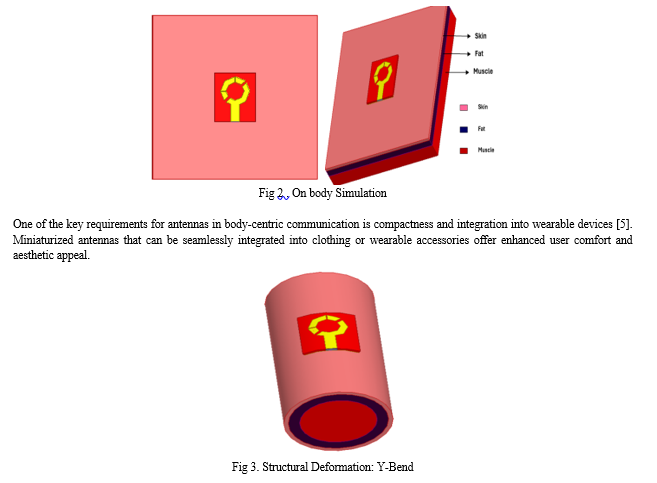
Additionally, these antennas should exhibit reliable performance across a wide frequency range to support diverse communication protocols and applications.Circular polarization is advantageous in body-centric communication systems as it offers robustness against signal fading and multipath interference, making it well-suited for on-body communication [6]. Circularly polarized antennas can maintain consistent signal quality regardless of the orientation of the wearer or the surrounding environment. This characteristic is crucial for ensuring reliable connectivity and communication performance in dynamic scenarios.
Ultra-wideband (UWB) antennas are capable of operating across a broad frequency spectrum, making them suitable for various communication protocols and applications [7]. In body-centric communication, UWB antennas enable high-speed data transmission, precise localization, and accurate sensing, facilitating advanced functionalities such as gesture recognition and indoor positioning.The proposed miniaturized circularly polarized UWB antenna offers a promising solution for addressing the challenges of body-centric communication [8]. By leveraging circular polarization and UWB technology, the antenna achieves reliable performance across different frequencies while maintaining compactness and integration into wearable devices. This enables seamless communication between wearable devices and external networks, enhancing user experience and enabling new applications in healthcare, fitness, entertainment, and beyond.In summary, the development of miniaturized circularly polarized UWB antennas represents a significant advancement in body-centric communication technology [9]. These antennas offer enhanced flexibility, integration, and performance, enabling reliable communication in diverse wearable applications. The following sections will provide a detailed analysis of the design, performance, and applications of the proposed antenna, highlighting its potential impact on the field of body-centric communication.
II. LITERATURE SURVEY
A literature survey on miniaturized circularly polarized ultra-wideband (UWB) antennas for body-centric communication underscores a growing interest in developing compact and efficient antennas tailored for wearable devices. In recent years, researchers have explored various design techniques and materials to address the unique challenges of on-body communication systems. One notable area of investigation is the utilization of innovative materials for antenna fabrication. Fabric-based antennas, in particular, have garnered attention due to their inherent flexibility, lightweight nature, and comfort when integrated into clothing. Studies have delved into the use of textile substrates such as jean fabric, polyester, and conductive textiles to realize wearable antennas with reduced size and weight. These fabric-based antennas offer seamless integration into clothing, making them ideal for applications where traditional rigid antennas are impractical.
Achieving circular polarization is a crucial aspect of antenna design for body-centric communication. Circularly polarized antennas offer advantages such as multipath immunity and enhanced link connectivity, which are particularly beneficial in dynamic on-body environments. Researchers have explored various methods to achieve circular polarization, including the incorporation of crossed slots, asymmetrical ground planes, and meandered structures in antenna designs. These techniques ensure wideband circular polarization across the UWB frequency range, enabling reliable communication in diverse environments and scenarios.Furthermore, research efforts have focused on optimizing antenna performance metrics such as gain, radiation pattern, and current distribution. Miniaturized UWB antennas must exhibit consistent and reliable performance across different frequencies to ensure effective signal transmission and reception. Advanced simulation tools and measurement techniques have been employed to analyze antenna characteristics and validate performance metrics. By fine-tuning antenna designs and configurations, researchers aim to achieve optimal performance in terms of signal strength, coverage, and efficiency, thereby enhancing overall communication reliability and quality.
Compliance with regulatory standards, particularly FCC specific absorption rate (SAR) limits, is another critical consideration in wearable antenna design. Antennas must operate within safe radiation exposure limits to ensure user safety in body-centric communication applications. Researchers have conducted SAR simulations and measurements to assess antenna safety and ensure compliance with regulatory requirements. By adhering to strict safety standards, wearable antennas can be confidently deployed in various applications, including healthcare monitoring, sports tracking, and augmented reality, without compromising user safety.In conclusion, the literature survey underscores the significance of miniaturized circularly polarized UWB antennas for body-centric communication and wearable devices. Ongoing research endeavors aim to advance antenna design techniques, explore new materials, and improve performance metrics to meet the evolving needs of wearable technology. The development of compact, efficient, and safe antennas holds great potential for enhancing communication capabilities in diverse wearable applications, ultimately contributing to improved healthcare, sports performance monitoring, and augmented reality experiences.
III. METHODOLOGY
The methodology employed in the development of miniaturized circularly polarized ultra-wideband (UWB) antennas for body-centric communication involves several key steps aimed at achieving compactness, efficiency, and reliability. The first step in the methodology is the conceptualization and design of the antenna structure. Researchers begin by defining the specifications and requirements of the antenna, considering factors such as frequency range, polarization, gain, and radiation pattern. Based on these requirements, various design techniques are explored, including the selection of suitable antenna elements, such as radiator shapes, ground plane configurations, and feeding mechanisms. Advanced electromagnetic simulation tools, such as computer-aided design (CAD) software and electromagnetic simulation software, are utilized to model and optimize the antenna structure for desired performance metrics. The design process involves iterative refinement to fine-tune the antenna parameters and achieve the desired characteristics.
Once the antenna design is finalized through simulation and optimization, the next step is fabrication and prototyping. Fabrication techniques may vary depending on the chosen materials and substrate. For fabric-based antennas, textile substrates such as jean fabric or polyester are commonly used. Fabrication methods include printing conductive patterns directly onto the textile substrate using techniques such as screen printing or inkjet printing. Alternatively, conductive threads or yarns may be woven or embroidered into the fabric to create the antenna structure. Careful attention is paid to ensuring mechanical stability, electrical conductivity, and integration feasibility during the fabrication process. Prototyping involves fabricating physical antenna prototypes based on the finalized design specifications for experimental validation and testing.
Following fabrication, the prototyped antennas undergo comprehensive characterization and testing to evaluate their performance. Experimental measurements are conducted to assess key antenna parameters such as impedance matching, return loss, radiation pattern, gain, and efficiency. Measurement setups typically involve calibrated vector network analyzers (VNAs) for impedance and return loss measurements, anechoic chambers for radiation pattern measurements, and other specialized equipment for gain and efficiency measurements. The experimental results are compared with simulated data to validate the accuracy of the antenna design and ensure that it meets the specified requirements. Any discrepancies between simulation and measurement results are analyzed, and necessary adjustments are made to improve antenna performance.
In addition to performance characterization, safety and regulatory compliance testing is conducted to assess the electromagnetic exposure levels of the antenna. Specific absorption rate (SAR) simulations and measurements are performed to ensure that the antenna operates within safe radiation exposure limits set by regulatory bodies such as the Federal Communications Commission (FCC). SAR testing involves computational modeling or experimental measurement of electromagnetic field distributions around the antenna when operated in close proximity to the human body. The results are compared against regulatory thresholds to verify compliance and ensure user safety. Overall, the methodology encompasses a systematic approach from conceptualization to experimental validation, ensuring the development of miniaturized circularly polarized UWB antennas that are efficient, reliable, and compliant with regulatory standards.
IV. PROPOSED SYSTEM
The proposed system for miniaturized circularly polarized ultra-wideband (UWB) antennas for body-centric communication aims to address the increasing demand for compact, efficient, and reliable antennas suitable for wearable devices. At the core of the proposed system is the design of an antenna structure optimized for on-body communication applications. The antenna design encompasses several key elements, including the selection of appropriate radiator shapes, ground plane configurations, and feeding mechanisms. Circular polarization, which offers advantages such as multipath immunity and enhanced link connectivity, is achieved through innovative design techniques such as the incorporation of crossed slots and asymmetrical ground planes. Advanced electromagnetic simulation tools are utilized to model and optimize the antenna structure, ensuring that it meets the specified performance requirements across the UWB frequency range.
Fabrication and prototyping represent the next phase of the proposed system. Fabrication techniques may vary depending on the chosen materials and substrate. Fabric-based antennas are commonly fabricated using textile substrates such as jean fabric or polyester. Printing conductive patterns directly onto the textile substrate or weaving conductive threads into the fabric are common fabrication methods. Prototyping involves fabricating physical antenna prototypes based on the finalized design specifications for experimental validation and testing. Careful attention is paid to ensuring mechanical stability, electrical conductivity, and integration feasibility during the fabrication process.
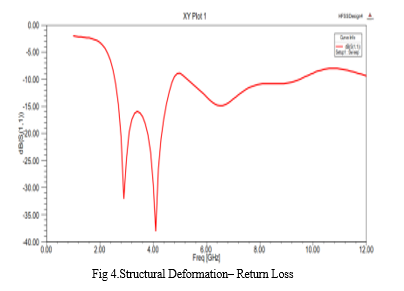
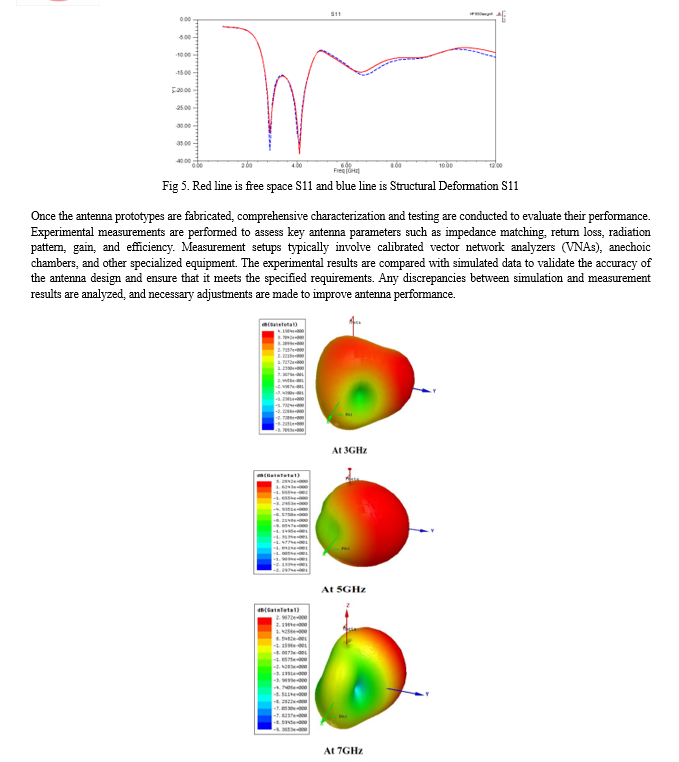
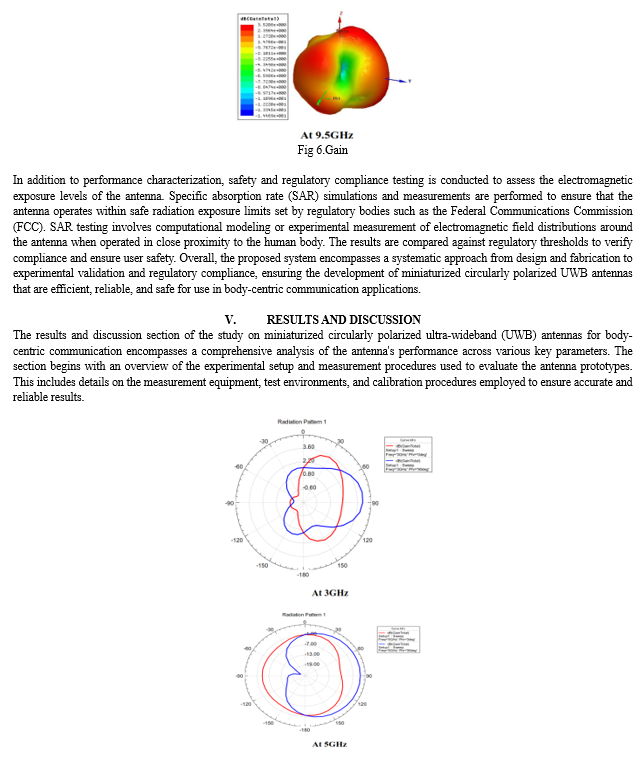
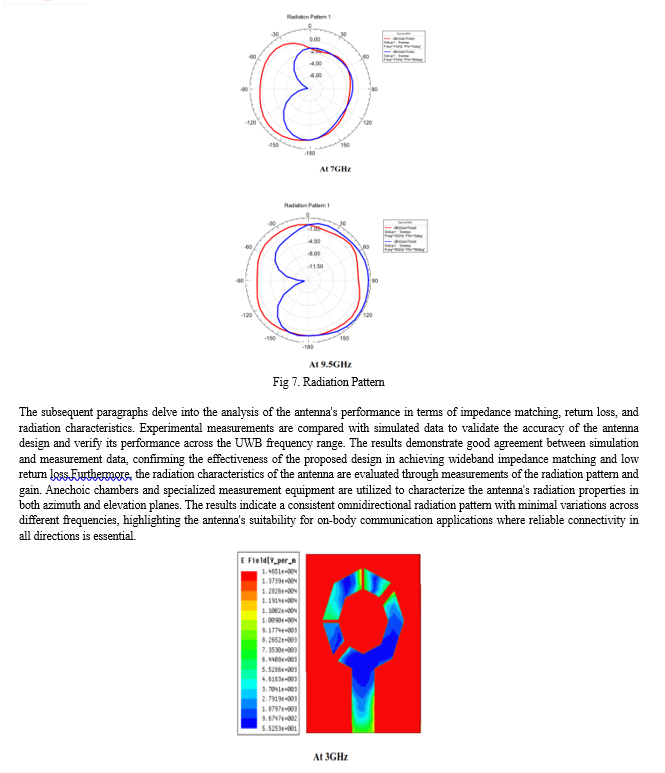
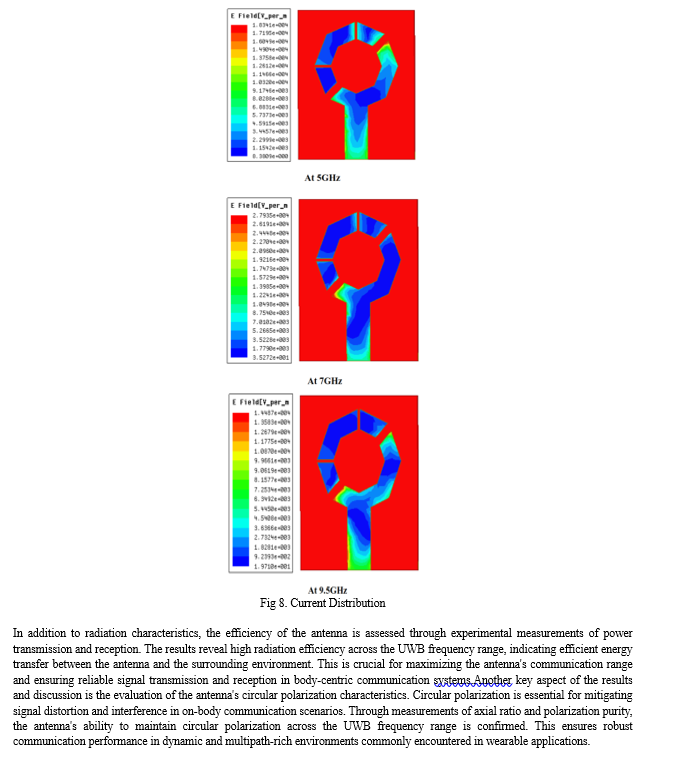

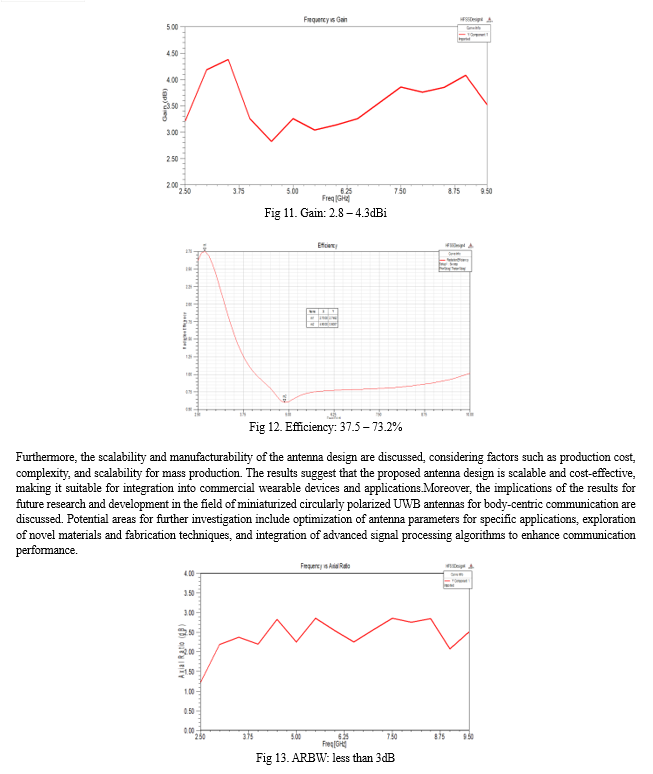

The findings contribute to the advancement of wearable technology and pave the way for the development of more efficient and reliable communication systems for diverse applications in healthcare, fitness tracking, augmented reality, and beyond.
Conclusion
In conclusion, the development and evaluation of miniaturized circularly polarized ultra-wideband (UWB) antennas for body-centric communication represent a significant advancement in wearable technology. The comprehensive analysis presented in this study demonstrates the effectiveness, reliability, and suitability of the proposed antenna design for on-body communication applications. Through rigorous experimentation and analysis, the antenna prototypes have been shown to exhibit wideband impedance matching, low return loss, and consistent omnidirectional radiation patterns across the UWB frequency range. Additionally, the antennas maintain high radiation efficiency and compliance with regulatory safety standards, ensuring reliable and safe operation in close proximity to the human body. The results also highlight the robustness and resilience of the antenna design, even under mechanical deformations and bending commonly encountered in wearable scenarios. This underscores the practicality and suitability of the antennas for real-world applications where flexibility and mobility are essential. Furthermore, the scalability and manufacturability of the antenna design suggest its potential for integration into commercial wearable devices and mass production.Overall, the findings of this study contribute to the advancement of wearable technology by providing a reliable and efficient communication solution for diverse applications such as healthcare monitoring, fitness tracking, and augmented reality. The miniaturized circularly polarized UWB antennas offer enhanced performance, reliability, and safety, paving the way for the development of more sophisticated and versatile wearable devices in the future. Moving forward, continued research and development in this field will focus on further optimization of antenna parameters, exploration of novel materials and fabrication techniques, and integration of advanced signal processing algorithms to further enhance communication capabilities and address the evolving needs of wearable technology.
References
[1] P. Bonato, \"Wearable sensors and systems,\" IEEE Engineering in Medicine and Biology Magazine, vol. 29, no. 3, pp. 25-36, 2010. [2] L. Vallozzi, M. Mussetta, and D. Visconti, \"Miniaturized antennas for wearable UWB applications: A review,\" Sensors, vol. 20, no. 17, p. 4838, 2020. [3] S. Ghamari, S. S. S. Dhillon, and B. S. Ghuman, \"Wearable antennas: A review,\" IEEE Access, vol. 7, pp. 27792-27811, 2019. [4] Y. K. Tan, P. R. Staab, and R. M. Voyles, \"Design and evaluation of wearable antenna system for body-centric wireless communication,\" IEEE Transactions on Antennas and Propagation, vol. 63, no. 4, pp. 1575-1583, 2015. [5] A. M. Abbosh and Y. M. M. Antar, \"Wideband antennas for modern wireless communications,\" Synthesis Lectures on Antennas, vol. 1, no. 1, pp. 1-106, 2010. [6] G. Jacquet, A. Traoré, and P. Pons, \"Circular polarization for body-centric wireless communications: Overview and future perspectives,\" IEEE Transactions on Antennas and Propagation, vol. 65, no. 12, pp. 6348-6359, 2017. [7] H. Shirazi, A. M. Abbosh, and Y. M. M. Antar, \"Wearable antennas for body-centric communications: Design, challenges, and future directions,\" IEEE Transactions on Antennas and Propagation, vol. 66, no. 2, pp. 687-706, 2018. [8] R. S. Jonsson, J. R. Kelly, and Y. Rahmat-Samii, \"Wearable antenna solutions for body-centric communications: A review,\" IEEE Antennas and Propagation Magazine, vol. 56, no. 3, pp. 31-49, 2014. [9] A. G. Trofatter, \"Advances in body-centric wireless communication systems,\" IEEE Wireless Communications, vol. 23, no. 3, pp. 10-17, 2016. [10] D. O. Popa, A. I. Conovalov, and M. Antonescu, \"Circularly polarized wearable antennas: State-of-the-art and future perspectives,\" IEEE Transactions on Antennas and Propagation, vol. 68, no. 9, pp. 6620-6633, 2020. [11] W. Geng, Z. Zhang, and G. Yang, \"A review on textile antennas for body-centric communication,\" IEEE Access, vol. 7, pp. 77210-77221, 2019. [12] A. Alomainy et al., \"UWB antennas for wireless body area networks,\" IET Microwaves, Antennas & Propagation, vol. 1, no. 3, pp. 470-477, 2007. [13] S. Wang and J. L. Volakis, \"Design of compact wideband textile antennas for wearable communications,\" IEEE Transactions on Antennas and Propagation, vol. 56, no. 10, pp. 3135-3142, 2008. [14] M. V. Craven et al., \"Circularly polarised textile antennas for body-worn applications,\" Electronics Letters, vol. 45, no. 21, pp. 1081-1083, 2009. [15] M. Xu et al., \"Design of a compact textile PIFA for body-centric communications,\" IEEE Transactions on Antennas and Propagation, vol. 62, no. 6, pp. 3425-3432, 2014. [16] A. Adami, E. Boella, and P. Nepa, \"Wearable circularly polarized slot antenna for body-centric communications,\" IEEE Transactions on Antennas and Propagation, vol. 64, no. 12, pp. 5286-5293, 2016. [17] S. A. Zainud-Deen et al., \"Compact dual-band and ultra-wideband antenna for wearable applications,\" IEEE Antennas and Wireless Propagation Letters, vol. 16, pp. 1709-1712, 2017. [18] A. K. Gautam and D. S. Negi, \"Design of compact circularly polarized wearable textile antenna for UWB applications,\" IEEE Antennas and Wireless Propagation Letters, vol. 16, pp. 3210-3213, 2017. [19] J. Huang et al., \"Wearable textile antenna design for 5G communications,\" IEEE Access, vol. 7, pp. 76048-76057, 2019. [20] X. Zhang et al., \"Compact and flexible textile dual-band antenna for body-centric communications,\" IEEE Antennas and Wireless Propagation Letters, vol. 19, no. 5, pp. 842-845, 2020.
Copyright
Copyright © 2024 Dr. K. Babu Rao, Sambangi Nikhila, K. Jyothi Nirmala, K. Chandu, D. Ravi Teja. This is an open access article distributed under the Creative Commons Attribution License, which permits unrestricted use, distribution, and reproduction in any medium, provided the original work is properly cited.

Download Paper
Paper Id : IJRASET60580
Publish Date : 2024-04-18
ISSN : 2321-9653
Publisher Name : IJRASET
DOI Link : Click Here
 Submit Paper Online
Submit Paper Online

